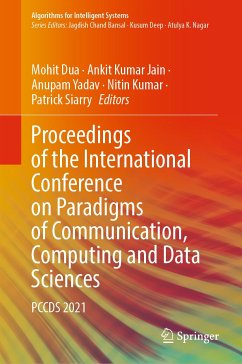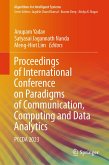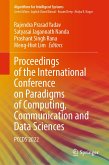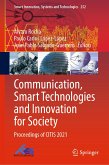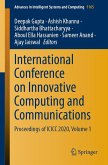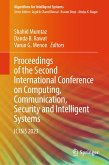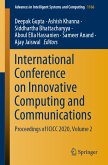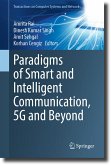Proceedings of the International Conference on Paradigms of Communication, Computing and Data Sciences (eBook, PDF)
PCCDS 2021
Redaktion: Dua, Mohit; Siarry, Patrick; Kumar, Nitin; Yadav, Anupam; Jain, Ankit Kumar
161,95 €
161,95 €
inkl. MwSt.
Sofort per Download lieferbar

81 °P sammeln
161,95 €
Als Download kaufen

161,95 €
inkl. MwSt.
Sofort per Download lieferbar

81 °P sammeln
Jetzt verschenken
Alle Infos zum eBook verschenken
161,95 €
inkl. MwSt.
Sofort per Download lieferbar
Alle Infos zum eBook verschenken

81 °P sammeln
Proceedings of the International Conference on Paradigms of Communication, Computing and Data Sciences (eBook, PDF)
PCCDS 2021
Redaktion: Dua, Mohit; Siarry, Patrick; Kumar, Nitin; Yadav, Anupam; Jain, Ankit Kumar
- Format: PDF
- Merkliste
- Auf die Merkliste
- Bewerten Bewerten
- Teilen
- Produkt teilen
- Produkterinnerung
- Produkterinnerung

Bitte loggen Sie sich zunächst in Ihr Kundenkonto ein oder registrieren Sie sich bei
bücher.de, um das eBook-Abo tolino select nutzen zu können.
Hier können Sie sich einloggen
Hier können Sie sich einloggen
Sie sind bereits eingeloggt. Klicken Sie auf 2. tolino select Abo, um fortzufahren.

Bitte loggen Sie sich zunächst in Ihr Kundenkonto ein oder registrieren Sie sich bei bücher.de, um das eBook-Abo tolino select nutzen zu können.
This book gathers selected high-quality research papers presented at the International Conference on Paradigms of Communication, Computing and Data Sciences (PCCDS 2021), held at the National Institute of Technology, Kurukshetra, India, during May 07-09, 2021. It discusses high-quality and cutting-edge research in the areas of advanced computing, communications, and data science techniques. The book is a collection of latest research articles in computation algorithm, communication, and data sciences, intertwined with each other for efficiency.
- Geräte: PC
- ohne Kopierschutz
- eBook Hilfe
- Größe: 21.72MB
Andere Kunden interessierten sich auch für
![Proceedings of International Conference on Paradigms of Communication, Computing and Data Analytics (eBook, PDF) Proceedings of International Conference on Paradigms of Communication, Computing and Data Analytics (eBook, PDF)]() Proceedings of International Conference on Paradigms of Communication, Computing and Data Analytics (eBook, PDF)226,95 €
Proceedings of International Conference on Paradigms of Communication, Computing and Data Analytics (eBook, PDF)226,95 €![Proceedings of the International Conference on Paradigms of Computing, Communication and Data Sciences (eBook, PDF) Proceedings of the International Conference on Paradigms of Computing, Communication and Data Sciences (eBook, PDF)]() Proceedings of the International Conference on Paradigms of Computing, Communication and Data Sciences (eBook, PDF)242,95 €
Proceedings of the International Conference on Paradigms of Computing, Communication and Data Sciences (eBook, PDF)242,95 €![Communication, Smart Technologies and Innovation for Society (eBook, PDF) Communication, Smart Technologies and Innovation for Society (eBook, PDF)]() Communication, Smart Technologies and Innovation for Society (eBook, PDF)169,95 €
Communication, Smart Technologies and Innovation for Society (eBook, PDF)169,95 €![International Conference on Innovative Computing and Communications (eBook, PDF) International Conference on Innovative Computing and Communications (eBook, PDF)]() International Conference on Innovative Computing and Communications (eBook, PDF)161,95 €
International Conference on Innovative Computing and Communications (eBook, PDF)161,95 €![Proceedings of the Second International Conference on Computing, Communication, Security and Intelligent Systems (eBook, PDF) Proceedings of the Second International Conference on Computing, Communication, Security and Intelligent Systems (eBook, PDF)]() Proceedings of the Second International Conference on Computing, Communication, Security and Intelligent Systems (eBook, PDF)186,95 €
Proceedings of the Second International Conference on Computing, Communication, Security and Intelligent Systems (eBook, PDF)186,95 €![International Conference on Innovative Computing and Communications (eBook, PDF) International Conference on Innovative Computing and Communications (eBook, PDF)]() International Conference on Innovative Computing and Communications (eBook, PDF)161,95 €
International Conference on Innovative Computing and Communications (eBook, PDF)161,95 €![Paradigms of Smart and Intelligent Communication, 5G and Beyond (eBook, PDF) Paradigms of Smart and Intelligent Communication, 5G and Beyond (eBook, PDF)]() Paradigms of Smart and Intelligent Communication, 5G and Beyond (eBook, PDF)129,95 €
Paradigms of Smart and Intelligent Communication, 5G and Beyond (eBook, PDF)129,95 €-
-
-
This book gathers selected high-quality research papers presented at the International Conference on Paradigms of Communication, Computing and Data Sciences (PCCDS 2021), held at the National Institute of Technology, Kurukshetra, India, during May 07-09, 2021. It discusses high-quality and cutting-edge research in the areas of advanced computing, communications, and data science techniques. The book is a collection of latest research articles in computation algorithm, communication, and data sciences, intertwined with each other for efficiency.
Dieser Download kann aus rechtlichen Gründen nur mit Rechnungsadresse in A, B, BG, CY, CZ, D, DK, EW, E, FIN, F, GR, HR, H, IRL, I, LT, L, LR, M, NL, PL, P, R, S, SLO, SK ausgeliefert werden.
Produktdetails
- Produktdetails
- Verlag: Springer Nature Singapore
- Seitenzahl: 871
- Erscheinungstermin: 1. Januar 2022
- Englisch
- ISBN-13: 9789811657474
- Artikelnr.: 63225623
- Verlag: Springer Nature Singapore
- Seitenzahl: 871
- Erscheinungstermin: 1. Januar 2022
- Englisch
- ISBN-13: 9789811657474
- Artikelnr.: 63225623
- Herstellerkennzeichnung Die Herstellerinformationen sind derzeit nicht verfügbar.
Dr. Mohit Dua did his B.Tech degree in computer science and engineering from Kurukshetra University, Kurukshetra, India, in 2004 and M. Tech degree in computer engineering from National Institute of Technology, Kurukshetra, India, in 2012. He received Ph.D. in the area of speech recognition from the National Institute of Technology, Kurukshetra, India, in 2018. He is presently working as Assistant Professor in the Department of Computer Engineering at NIT Kurukshetra, India, with more than 16 years of academic experience. He is Life Member of Computer Society of India (CSI) and Indian Society for Technical Education (ISTE). His research interests include speech processing, theory of formal languages, statistical modeling, and natural language processing. He has published more than 60 research papers in various reputed journals and conferences. Dr. Ankit Kumar Jain is presently working as Assistant Professor in the National Institute of Technology, Kurukshetra, India. He received master of technology from the Indian Institute of Information Technology Allahabad (IIIT), India, and Ph.D. degree from the National Institute of Technology, Kurukshetra. His general research interest is in the area of information and cyber security, phishing Web site detection, Web security, mobile security, IoT security, online social network, and machine learning. He has published more than 35 papers in reputed journals and conferences. Dr. Anupam Yadav is Assistant Professor, Department of Mathematics, Dr. BR Ambedkar National Institute of Technology Jalandhar, India. His research area includes numerical optimization, soft computing, and artificial intelligence, and he has more than ten years of research experience in the areas of soft computing and optimization. He has done a Ph.D. in soft computing from the Indian Institute of Technology Roorkee, and he had worked as a research professor at Korea University. He has published more than twenty-five research articles in journals of international repute, and has published more than fifteen research articles in conference proceedings. He has authored a textbook entitled "An introduction to neural network methods for differential equations." He has edited three books which are published by AISC, Springer Series. He was General Chair, Convener, and Member of the Steering Committee of several international conferences. He is Member of various research societies. Dr. Nitin Kumar has been working as Assistant Professor in the Department of Computer Science and Engineering at the National Institute of Technology, Uttarakhand, since 2013. He has obtained his M. tech. and Ph.D. in computer science and technology from the School of Computer and Systems Sciences, Jawaharlal Nehru University. He has published more than 50 research papers in reputed international journals and international conferences in India and abroad.His current research interests include pattern recognition, biometric recognition and security, image processing, and computer vision. Professor Patrick Siarry was born in France in 1952. He received the Ph.D. degree from the University Paris 6, in 1986, and the Doctorate of Sciences (Habilitation) from the University Paris 11, in 1994. He was first involved in the development of analog and digital models of nuclear power plants at Electricité de France (E.D.F.). Since 1995, he is Professor in automatics and informatics. His main research interests are computer-aided design of electronic circuits and the applications of new stochastic global optimization heuristics to various engineering fields. He is also interested in the fitting of process models to experimental data and the learning of fuzzy rule bases and of neural networks.
Part 1: Communication.- Chapter 1. Simulation and Implementation of Circular Microstrip Patch Antenna.- Chapter 2. Reflection Characteristics Improvement of Wide Band Coupled Line Power Divider Using SRR.- Chapter 3. All-Optical Frequency Encoded Dibit-based Half Subtractor using Reflective Semiconductor Optical Amplifier with Simulative Verification.- Chapter 4. An Improved CMOS Ring VCO Design with Resistive-Capacitive Tuning Method.- Chapter 5. Forwarding Strategy in SDN based Content Centric Network.- Chapter 6. Joint Subcarrier Mapping with Relay Selection Based Physical Layer Security Scheme for Ofdm System.- Chapter 7. Prefeasibility economic scrutiny of the off-grid hybrid renewable system for remote area electrification.- Chapter 8. Wearable slotted patch antenna with the defected ground structure for biomedical applications.- Chapter 9. A Secure and Reliable Architecture for User Authentication through OTP in Mobile Payment System.- Chapter 10. Android Stack Vulnerabilities:Security Analysis of a Decade.- Chapter 11. Three-factor User-Authentication Protocol for Wireless Sensor Networks - A Review.- Chapter 12. Trade-off Between Memory and Model Based Collaborative Filtering Recommender System.- Chapter 13. RAT Selection Strategies for Next-generation Wireless Net-works: A Taxonomy and Survey.- Chapter 14. Range-free Localization by Optimization in Anisotropic WSN.- Chapter 15. Polarized Diversity characteristics Dual band MIMO Antenna for 5G/WLAN Applications.
Part 1: Communication.- Chapter 1. Simulation and Implementation of Circular Microstrip Patch Antenna.- Chapter 2. Reflection Characteristics Improvement of Wide Band Coupled Line Power Divider Using SRR.- Chapter 3. All-Optical Frequency Encoded Dibit-based Half Subtractor using Reflective Semiconductor Optical Amplifier with Simulative Verification.- Chapter 4. An Improved CMOS Ring VCO Design with Resistive-Capacitive Tuning Method.- Chapter 5. Forwarding Strategy in SDN based Content Centric Network.- Chapter 6. Joint Subcarrier Mapping with Relay Selection Based Physical Layer Security Scheme for Ofdm System.- Chapter 7. Prefeasibility economic scrutiny of the off-grid hybrid renewable system for remote area electrification.- Chapter 8. Wearable slotted patch antenna with the defected ground structure for biomedical applications.- Chapter 9. A Secure and Reliable Architecture for User Authentication through OTP in Mobile Payment System.- Chapter 10. Android Stack Vulnerabilities:Security Analysis of a Decade.- Chapter 11. Three-factor User-Authentication Protocol for Wireless Sensor Networks - A Review.- Chapter 12. Trade-off Between Memory and Model Based Collaborative Filtering Recommender System.- Chapter 13. RAT Selection Strategies for Next-generation Wireless Net-works: A Taxonomy and Survey.- Chapter 14. Range-free Localization by Optimization in Anisotropic WSN.- Chapter 15. Polarized Diversity characteristics Dual band MIMO Antenna for 5G/WLAN Applications.
